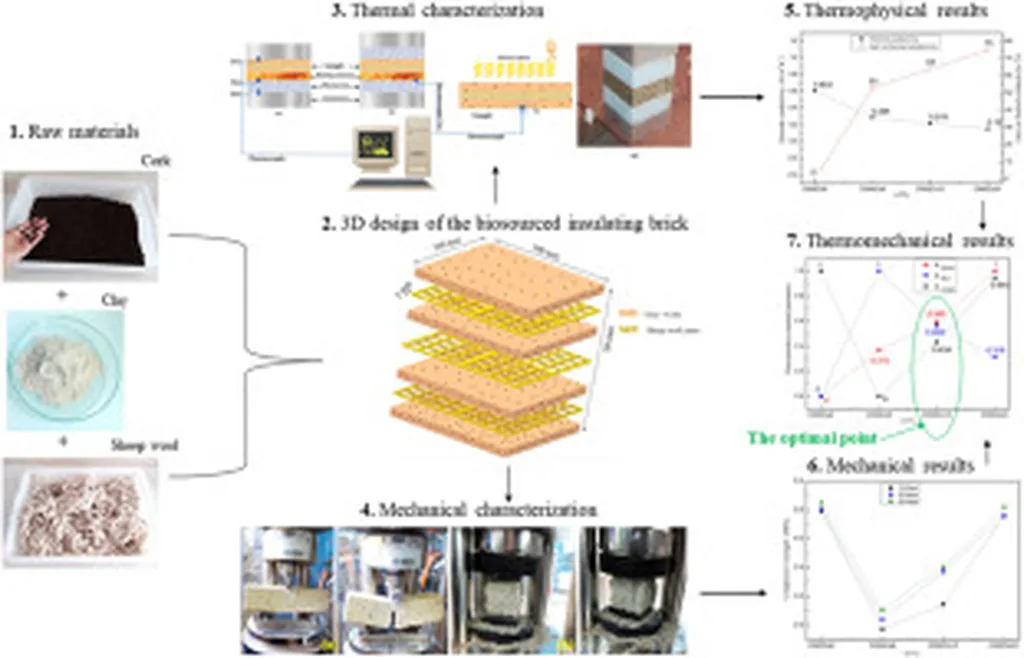In the quest for sustainable construction materials, a team of researchers led by Fatima Zohra El Wardi from the Physics Department at Hassan II University in Casablanca, Morocco, has made a significant breakthrough. Their study, published in the journal Open Ceramics (which translates to “Open Ceramics” in English), explores the development and evaluation of a fired clay-cork composite designed to enhance thermal insulation in buildings. This innovation could have profound implications for the energy sector, particularly in reducing the carbon footprint of construction materials and improving energy efficiency in buildings.
The research focuses on creating a composite material by incorporating cork particles into clay and firing it at 780 °C. This process generates a porous structure as the cork burns away, resulting in a material with enhanced thermal insulation properties. “The key to this innovation lies in the unique combination of clay and cork,” explains El Wardi. “Cork, an industrial by-product, not only improves the thermal performance of the material but also contributes to sustainability by utilizing a waste product.”
The study measured the thermal conductivity, diffusivity, and effusivity of the composite using advanced methods such as flash and asymmetrical hot plate techniques. The results were compared to theoretical models to ensure accuracy. Mechanical performance was also assessed through compressive and flexural strength tests. The findings revealed that increasing the cork content from 2% to 10% by mass significantly enhances porosity, reducing the bulk density of the material. This, in turn, leads to a substantial decrease in thermal conductivity, making the composite an excellent insulator.
“One of the most exciting aspects of this research is the potential for energy savings,” says El Wardi. “Our thermal simulations showed that buildings using this composite could achieve energy and environmental savings of up to 37%.” This is a game-changer for the energy sector, as buildings account for a significant portion of global energy consumption. By improving the thermal efficiency of building materials, the composite could help reduce energy demand and lower carbon emissions.
However, the study also highlights a trade-off between thermal performance and mechanical strength. While the composite’s thermal insulation improves with higher cork content, its mechanical strength decreases. The researchers identified a structural threshold at 3.68% cork content, which balances thermal efficiency with sufficient compressive strength for building applications. “This threshold is crucial for practical applications,” notes El Wardi. “It ensures that the material is both thermally efficient and structurally sound.”
The Schiller and Hasselman models were found to best describe the strength-porosity behavior of the composite, providing a theoretical framework for future research and development. The study’s findings contribute to the growing body of knowledge on sustainable building materials and offer a promising solution for the construction industry.
As the world grapples with the challenges of climate change and the need for sustainable development, innovations like the fired clay-cork composite are more important than ever. This research not only advances our understanding of sustainable building materials but also paves the way for future developments in the field. By utilizing industrial by-products and improving thermal efficiency, the composite represents a step forward in the quest for low-carbon, energy-efficient construction solutions.
The implications for the energy sector are vast. As buildings become more energy-efficient, the demand for energy could decrease, leading to lower carbon emissions and a more sustainable future. This research is a testament to the power of innovation and the potential for sustainable solutions to address global challenges. With further development and commercialization, the fired clay-cork composite could become a staple in the construction industry, shaping the future of sustainable building practices.

